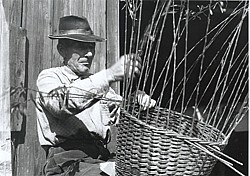Editorial board
In the folk production in Slovakia wicker has always been one the most popular materials. It was enabled by the general incidence of willow trees growing near rivers and brooks. At present, all three kinds of materials are used – peeled, unpeeled and breeded. Their application corresponds to the purpose for which the product is made. In the course of the centuries, basket making had overgrown production for one’s own consumption, became domestic manufacturing and, in individual cases, even developed into a craft. At the time of its biggest boom, at the turn of the 19th and 20th centuries, there were 270 qualified and more than 1000 unqualified home wickerwork producers registered in Slovakia, according to the statistics of ancient Hungary. Following the Second World War the Centre for Folk Art Production (ÚĽUV) started organising basket making in Slovakia. ÚĽUV was offering a large range of wickerwork products made chiefly of peeled, boiled wicker. After 1989 some producers have started their own businesses again, others are devoted to it as a hobby, having completed some of the basket making courses.
